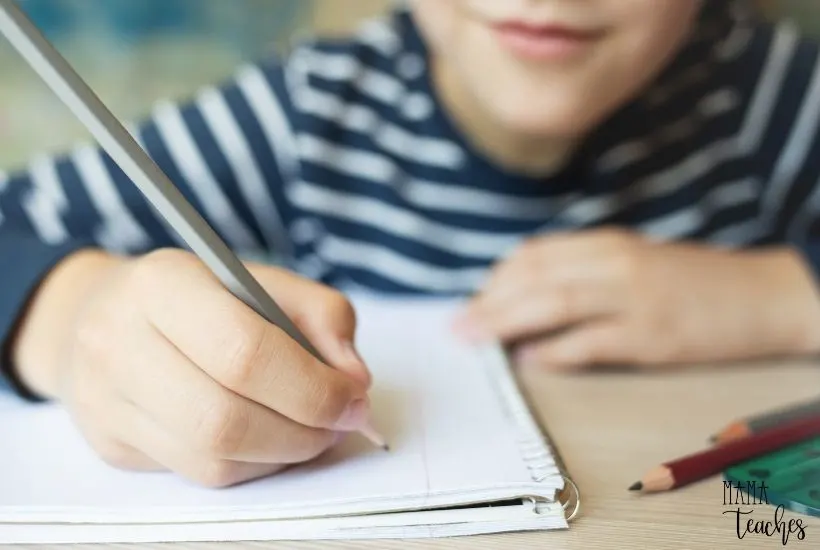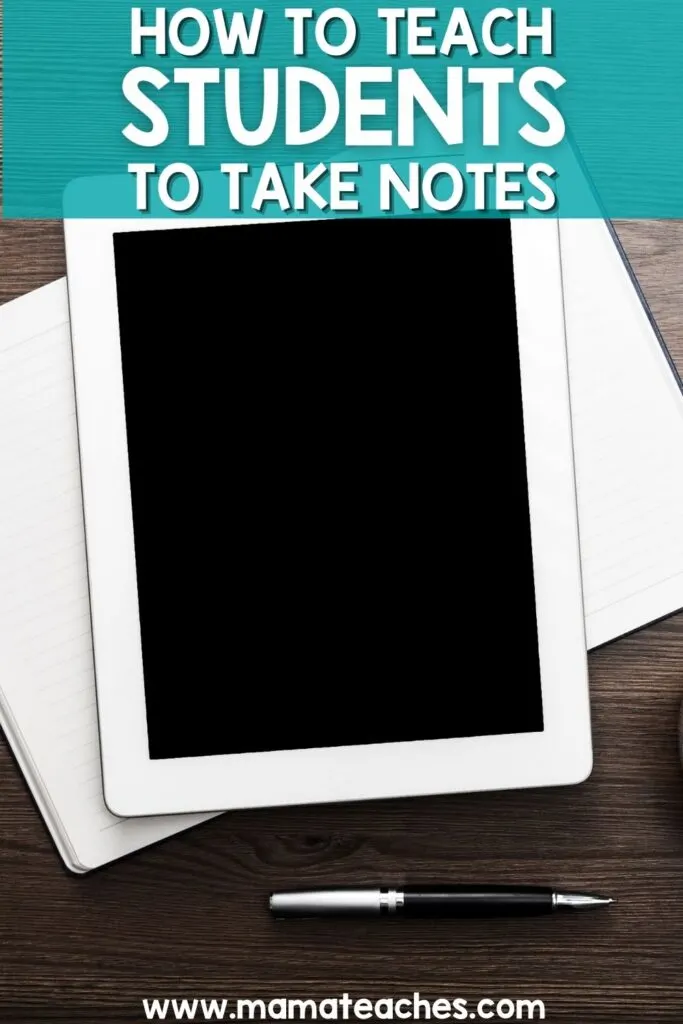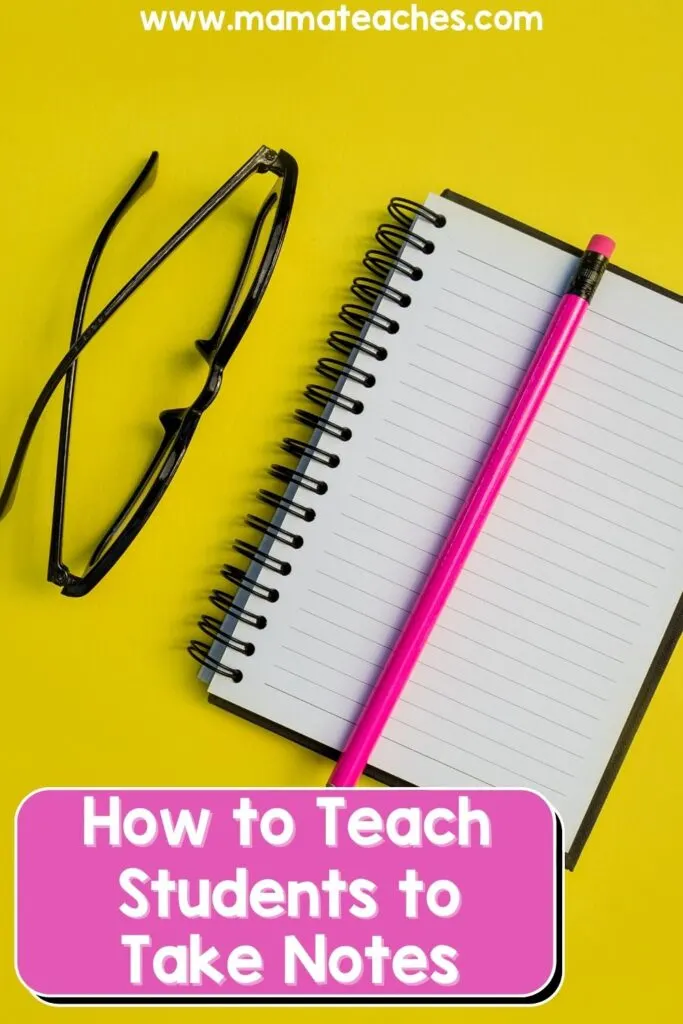Pencils ready?
Let’s jot down the essentials of teaching note-taking skills to students.
Teaching Note-Taking Skills
Taking notes is a skill, not an inborn quality.
It is beneficial for every student and every learning style.
Note-taking can be taught–but how do you do that?
We’ll go over the ins and outs of how to teach students to take notes.

This article contains affiliate links to things that you might like.
Why Is It Important to Take Notes?
Taking notes is a pivotal skill to master in preparation for high school and college.
You should start teaching it in middle school in order to prepare your students for heavier coursework, thick textbooks, and information-laden lectures.
Note-taking helps the student retain information.
This retention is reinforced both in the process of writing the notes and in reviewing them later.
Notes are also an excellent study tool.
They are the distilled information from a book or lecture.
Focusing on these important points is the best investment of a student’s time and energy.
Remember, note-taking is a learned skill.
It is possible for everyone to take notes and use them effectively, both to help them learn and to help them remember.

Taking Notes in Class
All students can benefit from learning how to take notes during a class lecture.
During class, a teacher will pull out what he or she feels is the most pivotal information.
These are the key pieces of information that will lead to understanding the concept or idea.
These are also the kinds of things most likely to be on a test.
Many students find that taking notes during class is a challenge.
It is easy to fall behind; the teacher moves on to a new topic while you are still jotting down the last thing she said.
Listening to one thing while writing another is disorienting.
This can be overcome when you know what to write down.
You never take notes on the entirety of a lecture.
Remember, much of what the teacher is saying is already explained in the textbook.
Set the stage for success by reading over the chapter or section before you come to class.
Even if this is just a quick scan of the topics, titles, and pictures, it will orient you to what you are about to hear.
While taking notes in class, focus on writing down three types of information:
- Whatever the teacher writes on the board (especially diagrams, problems, and solutions)
- Verbal examples of a concept or special teacher comments (aka extra info not in the book)
- Questions and answers

Taking Notes While Reading
Have you ever read something only to discover you haven’t absorbed a single word?
Your eyes were skimming the words, but your mind was wandering.
Note-taking eliminates this problem by forcing your brain to summarize and pick out important information.
Taking notes while reading may seem like you are adding an extra step, but it actually saves you time in the long run.
It allows you to efficiently absorb what you are reading, and it provides you with a review of the important, relevant, and interesting information in the book.
Of course, you can take notes on a separate sheet of paper, but don’t neglect the “notes in the book” method.
Write summaries on the top of each page or at the end of each chapter.
Use sticky notes or highlighters to pull out notable quotations or spotlight terms.
If you are reading a work of fiction, keep a character chart or plot diagram of the book.
Who are the characters in this book and how would you describe them?
What are the actions that lead to the climax of the book, and how does it resolve?

The Cornell Method of Note Taking
Note-taking methods abound, from Roman numeral outlines to picture doodling.
One of the most effective methods is the Cornell Note Taking Method.
It was developed in the 1950s by Walter Pauk, the reading and study center director at Cornell University.
The beauty of this method is that it is a) simple and b) allows space for summary and reflections.
Here’s what you do:
- Using a sheet of looseleaf, draw a vertical line 2.5” from the left side. This forms your “Cue Column.”
- Now draw a horizontal line 2” up from the bottom. This is your “Summary Section.”
- The big block on the right side of the page is where you take notes during class. Again, the details you want to include are 1) whatever the teacher writes 2) special comments and examples and 3) questions and answers.
- As soon after the lecture as possible, write clear and concise cue words in the Cue Column. These are short summary words and phrases that reflect the body of your notes. This process strengthens your memory and provides a way to review the notes later.
- Summarize the page of notes in a sentence or two in the Summary Section. This summary should be in your own words. If you have a question that needs clarifying, write it here as well.
With this system, you can quickly review the concepts you heard.
To quiz yourself, you can cover the notes section and just look at your cue words.
See if you can expand on your words and remember what you wrote down during the lecture.

Note-Taking Strategies
Whatever note-taking method you choose, remember these strategies:
Main Points
Even if it seems obvious, always include the main points and important information.
These are the big ideas that tie all the information together.
New Information
If something is not in the book or is completely new to you, write it down.
Put It in Your Own Words
The process of summarizing and restating is more than just to prevent plagiarism.
You are actually forcing your brain to make connections, consider, and store the information in a more readily available place.

How to Take Notes
It is important to know how to teach students to take notes, so they have the tools to succeed in high school and beyond.
No matter what their learning style, notes help a student synthesize, study, and review new concepts and information.
